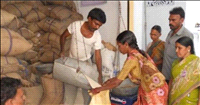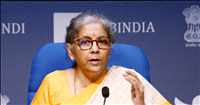Rural tele-density rises from 2 per cent to 8 per cent in one year: A Raja
14 Mar 2008
During the last one year, rural tele-density has increased from 2 per cent to nearly 8 per cent, much of it having been driven by wireless technology.
Inaugurating the conference on Emerging Trends in Wireless Technologies and Services organised by PTC India Foundation, in New Delhi today Raja said, "Low penetration in rural areas has been a cause of concern, but now since the last one year, rural telephony has come on the fast tract. During the last one year, rural tele-density has increased from 2 per cent to nearly 8 per cent. Much of the growth is driven by wireless technology".
He further added that the government's target of 25 per cent rural tele-density would require collective efforts by the government and the industry.
Initiatives of USO Fund for setting up towers in rural areas and sharing of infrastructure are some of the steps in this direction, he said.
Projecting India as a trendsetter in the field of telecommunications among the developing countries, Raja said that competition between different technologies has become quite fierce and has led to considerable debate. But as long as such debate helps the telecom sector, the industry and the users, it should be welcome.
He said that although voice telephony was important, more emphasis should be put to increase the penetration of broadband connections, which is presently alarmingly low at 3 million broadband connections only. Broadband connectivity was essential for supporting applications for socio-economic development of the masses, he added.
"Technologies have become available in recent years that do not require the layout of parallel networks," Raja said. "A common backbone network once available and spread up to all the district headquarters of the country, access to villages could be through wireless as key for rapid growth, while copper or fibre optic cable would be equally cost effective in certain cases. This includes broadband over 3G cellular or WiMAX, corDECT, broadband over power line (BPL) etc.", he added.
Communications secretary S Behura said that broad guidelines for 3rd Generation mobile services and Broadband Wireless Access Services have been announced recently. With this, the level of broadband penetration in the country, especially in rural areas will be addressed. Introduction of BWA services will enhance the penetration as well as growth in broadband subscribers.
Behura added that as radio frequency spectrum is a limited natural resource, the complexity and complication involved with accommodating new technologies required thoughtful consideration of number of issues like techno-economic, radio regulatory, etc. including balancing of conflicting and competing requirements.
Practically all frequency bands are shared amongst different types of radio-communication services for variety of applications and technologies. While considering the spectrum requirements of new emerging wireless technologies, the legitimate and genuine requirements of existing technologies and services cannot be ignored. Hence, the government's endeavour is to make room for accommodating new wireless technologies with adequate protection to existing operations.
The two-day conference, which got underway today in New Delhi, was also addressed by S D Saxena, chairman, PTCIF, and a presentation on 'broadband internet'/ WiMax-3G was made by R Shivakumar of Intel Technology.












.jpg)


.jpg)



.jpg)










